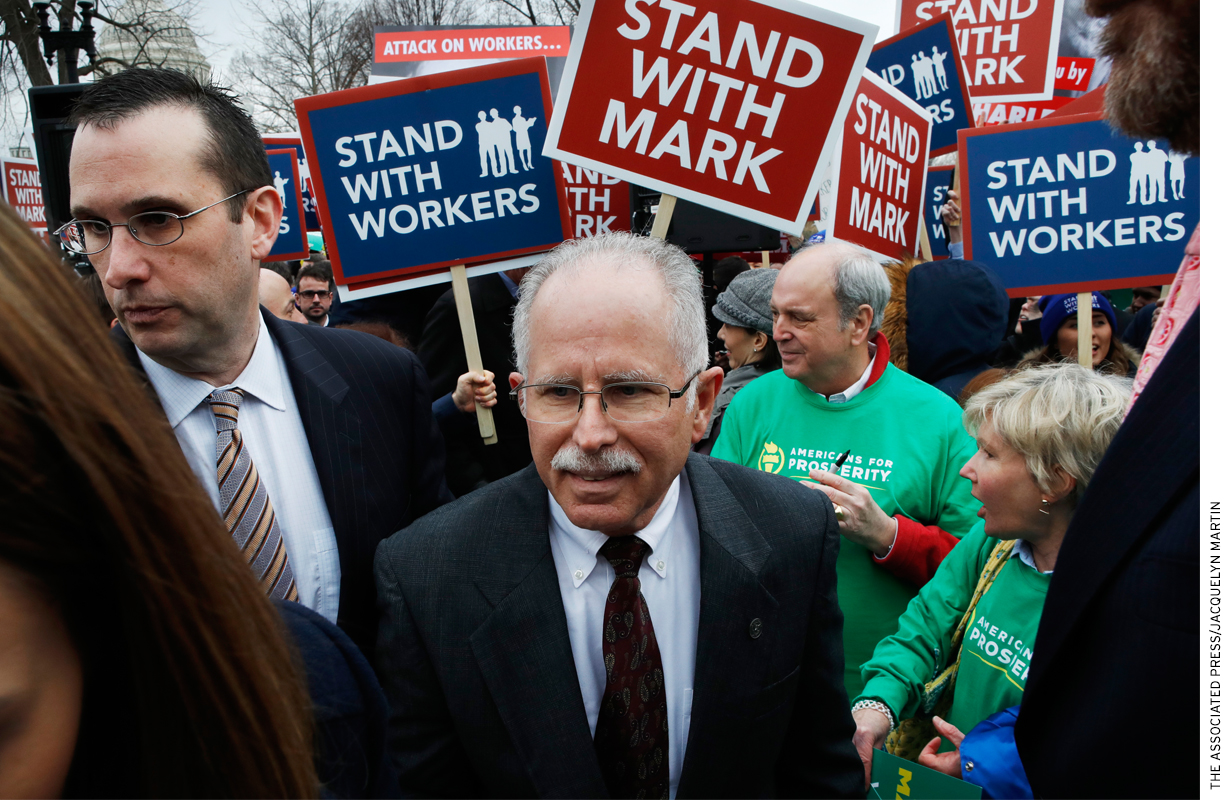
In Janus v. American Federation of State, County, and Municipal Employees, Council 31, the U.S. Supreme Court ended the practice of enabling public-sector unions to collect “fair-share” or “agency” fees from employees who decline to join. Although federal law prohibits requiring workers to join a union as a condition of employment, public-sector unions had been allowed to collect some portion of their dues from employees who do not wish to become members. These non-members were required to pay fair-share fees for the non-political activities that benefit all employees covered by the union contract.
The court enshrined the practice in 1977’s Abood v. Detroit Board of Education, which the Janus suit sought to undo. In the case, brought by a public-sector employee in Illinois, attorneys argued that public-sector unions’ actions and activities are inherently political, and thus the monthly $45 in fees deducted from plaintiff Mark Janus’s paychecks violates his First Amendment rights, because it amounts to paying a group to which he does not belong to lobby the government.
It was the third time the justices had heard arguments about fair-share fees in recent years, following Harris v. Quinn in 2014 and Friedrichs v. California Teachers Association in 2016. The justices stopped just short of making fair-share fees illegal in Quinn; Friedrichs ended in a 4–4 ruling after the unexpected passing of Justice Antonin Scalia; and the Abood precedent was upheld by the lower court. The 2017 appointment of Justice Neil Gorsuch gave the issue new life in court, with justices favoring the rights of employees not to be compelled to subsidize political speech they do not support over the rights of unions to charge fees for collective bargaining services.
Speculation about what this Janus defeat will mean for teachers unions has been rampant. Many, if not most, of the analysts who follow education policy and organized labor believe that the ruling will result in decreased power for teachers unions. The logic behind this assumption is simple: teachers unions will lose dues revenue because membership will decrease and former agency-fee payers will cease paying fees for union services. With fewer resources, teachers unions will have less ability to exert their influence in local, state, and federal elections and at the bargaining table. Fewer members, less money, less power. Right?
Not necessarily. Agency fees have been challenged at the state level over the past decade, and several states recently stopped allowing unions to collect them. The passage of those right-to-work laws may have caught state affiliates by surprise, unlike the widely anticipated Janus ruling. Even so, a close look at two of those states, Wisconsin and Michigan, may provide important clues about the future of teachers unions in a post-Janus world.
A Shifting Landscape for “Agency Fees”
Over the last eight years, six states have passed right-to-work legislation that bars unions from assessing fair-share fees for employees who do not wish to belong, in both the public and private sectors: Wisconsin (2011 and 2015), Michigan (2012), Indiana (2012), West Virginia (2016), Kentucky (2017), and Missouri (2017). As of May 2018, there were 22 states that allowed agency fees (see Figure 1).
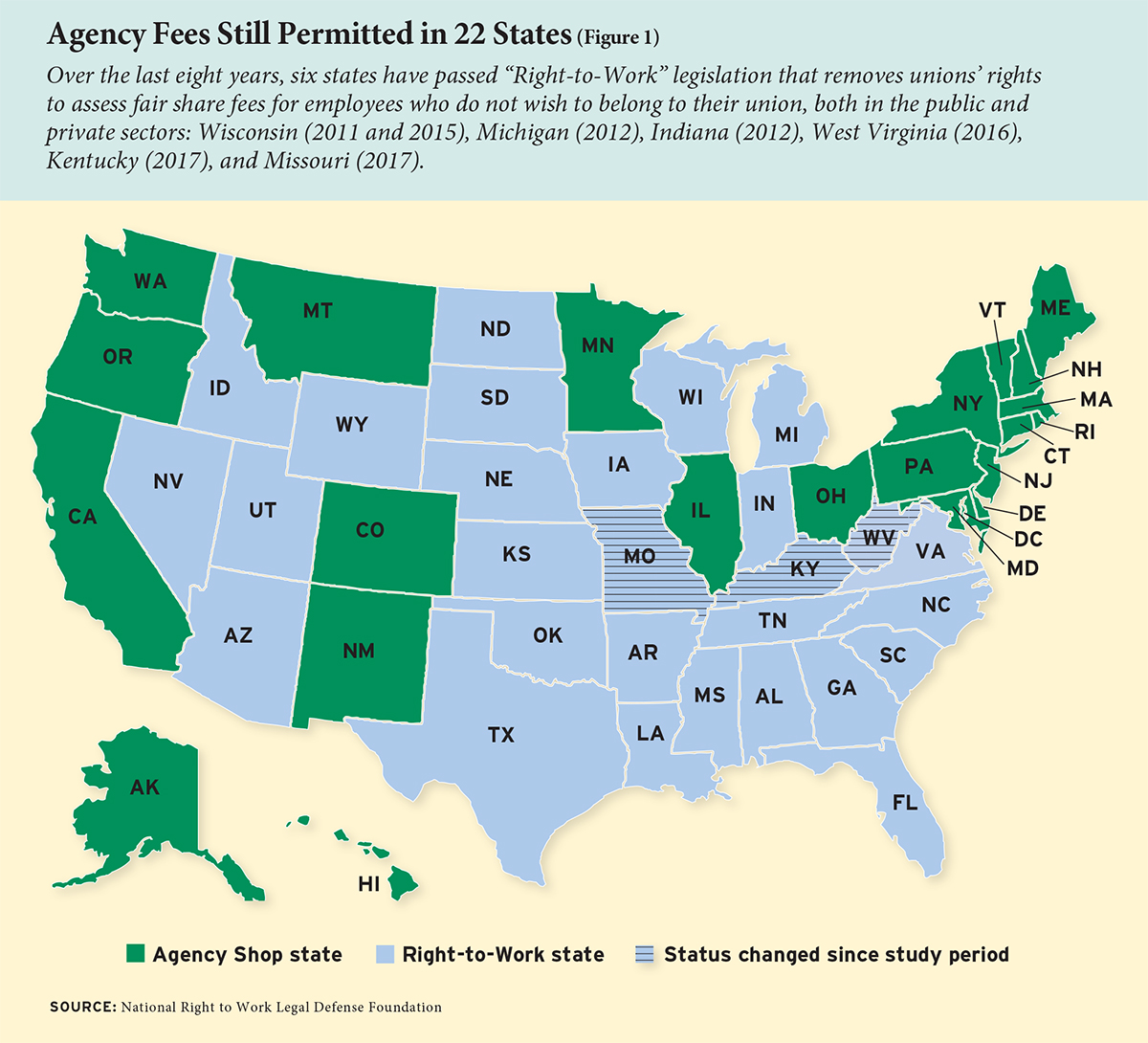
How did teachers unions fare in the wake of these laws? Were they rendered powerless? Could they adapt? Is a disruption like Janus a chance to reboot for the better?
To explore these questions, we examine state affiliates of the nation’s largest teachers union, the National Education Association (NEA), in Wisconsin and Michigan. We look at changes in membership rates, revenues, and campaign contributions from 2009‒16, the six-year period before and after their new right-to-work laws were adopted. We also interviewed two dozen teachers, administrators, and union officials in Michigan to gather insights about how they have coped on the ground.
We compare the Wisconsin and Michigan membership, revenue, and campaign-contribution trends to those of NEA affiliates in two other groups of states: the 25 states that allowed agency fees during the six-year period, which we call “agency-shop” states (including West Virginia, Missouri, and Kentucky), and the 23 states that had right-to-work laws on the books during this time and therefore did not allow fees, which we call “right-to-work” states.
We focus on Wisconsin and Michigan because the timing of their right-to-work laws provides us with sufficient pre- and post-reform data. We look solely at NEA state affiliates because the nation’s second-largest teachers union, the American Federation of Teachers (AFT), does not maintain clearly defined state-level organizations in all states. Finally, we consider Indiana a right-to-work state in our analysis because, although it did not officially adopt a right-to-work law until 2012, it has prohibited mandatory union membership and fee collection for teachers since 1995.
Declining Membership
As expected, NEA affiliate membership decreased in states that shifted to right-to-work status in recent years (see Figure 2). In Wisconsin, NEA membership dropped by more than half in the aftermath of the 2011 reform, from approximately 85,000 members to some 35,000 members in 2016. In Michigan, NEA membership was already dropping before the 2012 reform, in line with overall declines in the size of its student enrollment and teaching force. But the pace of the decline accelerated after 2013, with the number of members dropping from roughly 115,000 to 95,000 in 2016 and outpacing the continued decline in the number of teachers. In both comparison groups, membership rates remained steady.
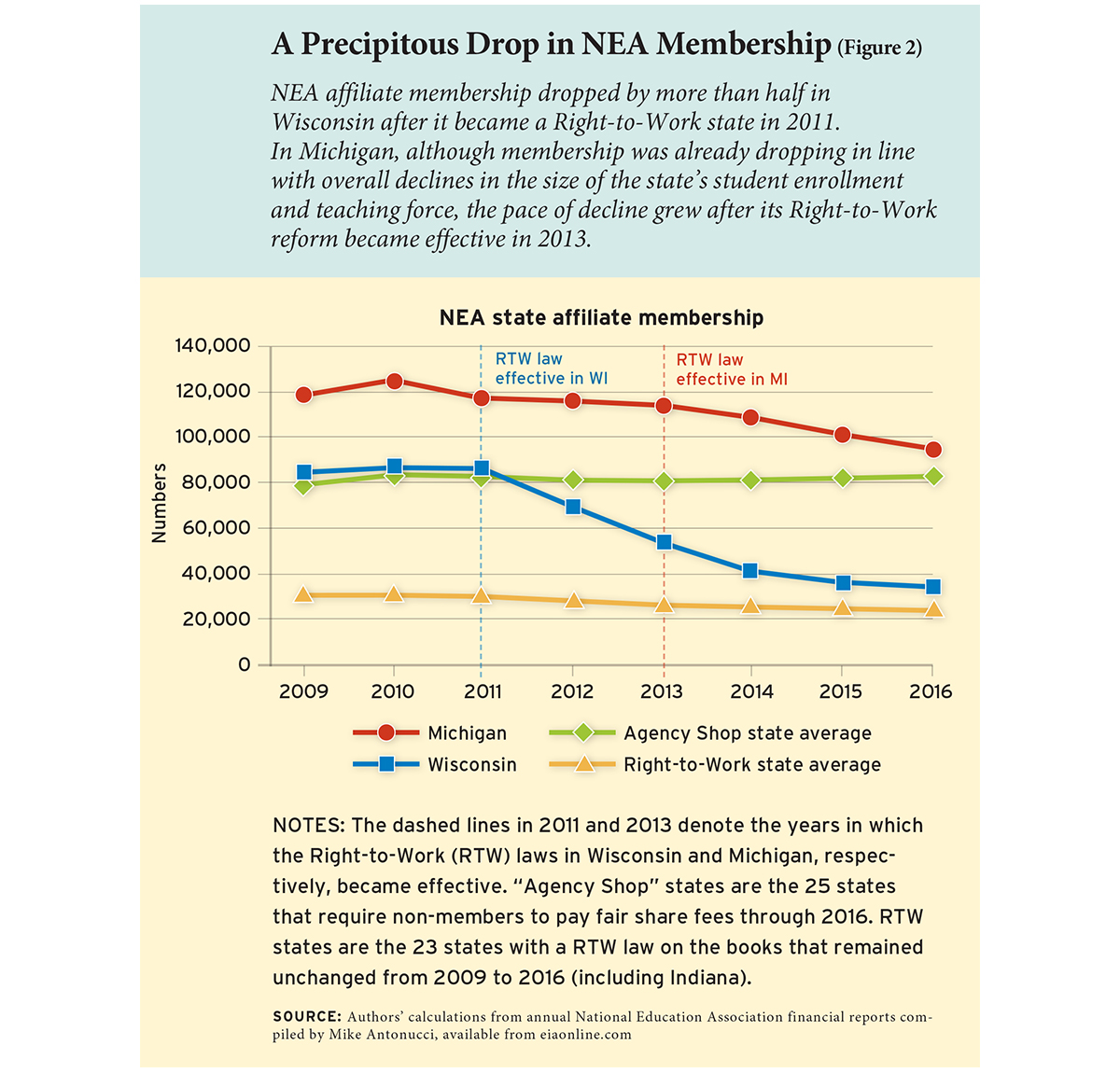
We more formally estimate how much membership trends in Michigan and Wisconsin deviate from those in states that did and did not allow fair-share fees using a statistical model that takes baseline trends into account. By comparing changes in Wisconsin and Michigan to changes in agency-shop states and states that had already adopted right-to-work laws, we account for contemporaneous changes in, for example, the national mood toward teachers unions or the overall health of the national economy, that might influence union resource and membership levels.
Our results from these models are descriptive rather than causal; apart from movement over time, we do not include controls for other factors that may affect outcomes. More important, agency-shop and right-to-work states differ from Michigan and Wisconsin in many ways, and so are not perfect comparison groups. The comparative analysis is nonetheless helpful in anticipating the likely consequences of the Janus decision.
Results from these models suggest that in the five years following right-to-work reform in Wisconsin, the NEA affiliate lost approximately 52 percent of its members, or 45,263, compared to stable trends in the agency-shop states. When comparing Wisconsin to right-to-work states, the membership decrease is 79 percent, or 68,247. In Michigan, in the three years after reform, the state NEA affiliate lost approximately 21 percent of its members, or 24,000, compared to trends in both the agency-shop and right-to-work states.
Although the precise reasons for decreases in union membership after the switch to right-to-work status are uncertain, our qualitative work in Michigan provides some clues. We interviewed 24 people in two school districts and at the state’s NEA affiliate, including district leaders, bargaining team members, local union presidents and members, and Michigan Education Association (MEA) leaders. In particular, one Michigan union leader told us:
I think a lot of the reason we lost numbers was just the inconvenience that was created by no longer allowing the school district to pull the union dues out of members’ paychecks. Now they’re actually physically paying. It’s kind of like when you put money into your retirement fund and you don’t even realize that it’s out of your paycheck. Now teachers are having to actually do it on their own with their own credit cards and their own bank accounts. I think that changed the mindset, “Oh I’m spending this amount of money” . . . Or people are members and then they get a new credit card, and it’s no longer getting pulled out, so they’re like, “Ah, forget it.” We’ve had a few of those. That seems to be part of it.
Dwindling Dues
If the inconvenience of having to actively choose to pay dues resulted in a loss of membership, as our interview subject suggests, that would translate into a commensurate loss of dues revenue. Indeed, that was the case (see Figure 3). In Wisconsin, dues revenue per teacher fell from $394 in 2011 to $116 by 2016. In Michigan, dues revenue per teacher fell from $761 in 2013 to $574 by 2016. In contrast, agency-shop states experienced steady increases in dues revenue per teacher over the same time period. Dues revenue per teacher remained relatively flat in right-to-work states during that time, as would be expected.
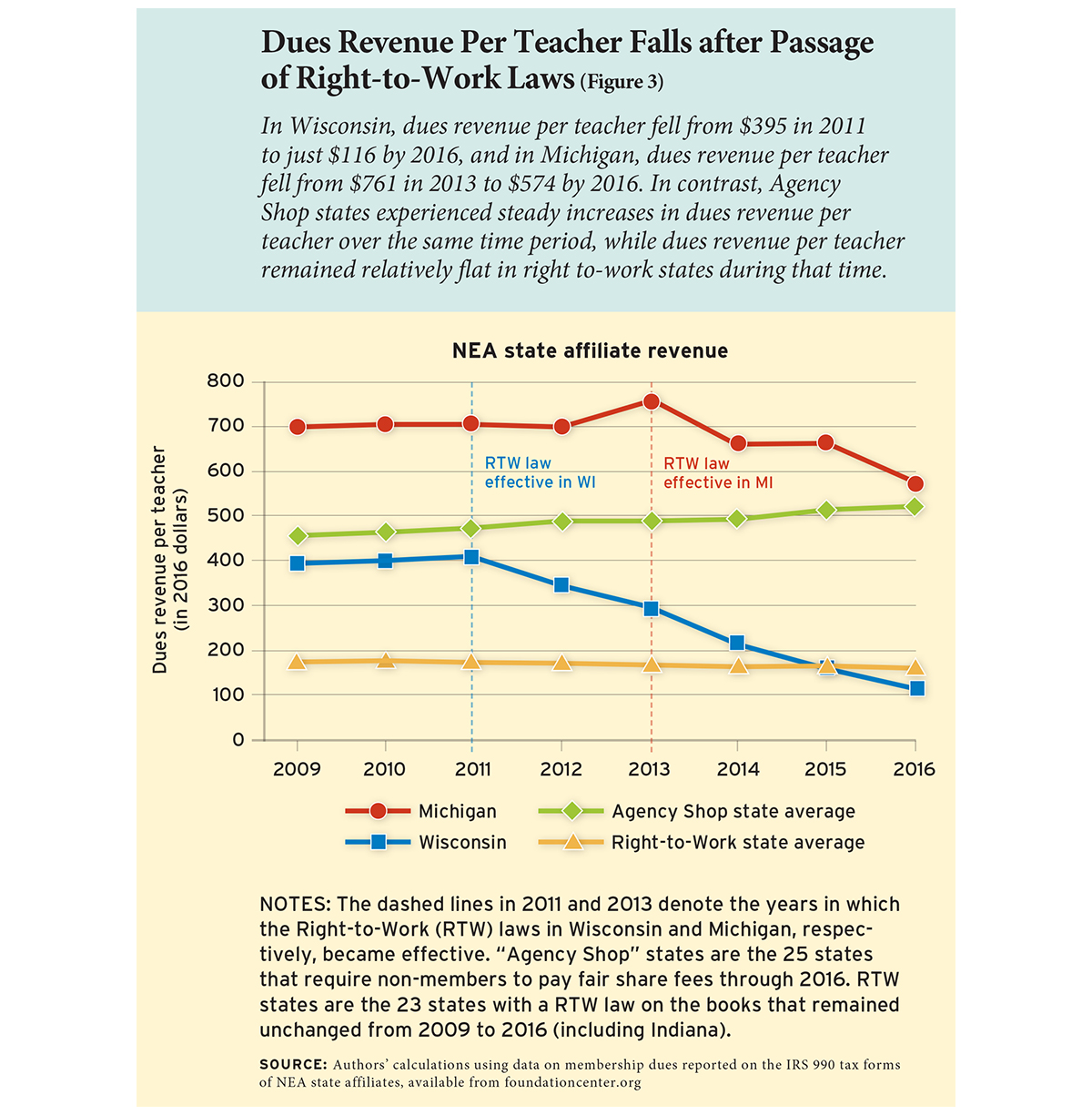
Our statistical analyses comparing these trends over time suggest that dues revenue per teacher decreased by $316 in Wisconsin and $186 in Michigan relative to agency-shop states by the end of 2016, or five years after reform in Wisconsin and three years after reform in Michigan. These figures suggest that, in states that adopted right-to-work laws, teachers unions not only lost power in numbers, but
they also lost muscle in terms of dollar resources.
Together, the evidence presented here suggests that, if trends from Wisconsin and Michigan are any guide, teachers unions may be permanently crippled in the wake of Janus. They will lose membership, which will result in steep declines in revenues, which in turn may curtail their ability to affect the policy process. Already, the NEA has been planning to cut its upcoming two-year budget by 13 percent, or $50 million, and is estimating membership losses at 10 percent, or 300,000 nationwide.
But in a panel discussion hosted by the Education Writers Association before the Janus decision was announced, NEA president Lily Eskelsen García expressed optimism about a resurgence in strength for teachers unions.
We’re seeing a greater level of activity now than we ever have before. But we still have to have one-on-one conversations with every educator. They need to know how we can help. The collective voice is all we have . . . and we’re not going anywhere.
She echoed those thoughts again in response to the decision.
We’re actually sitting down, one fee-payer at a time, going “On this day, you stopped paying fees. . . What would it take to have you be a member? . . . we need you to be a member not just to pay for that service, but to be a part of that greater voice.”
García may be right. As she notes, these are dark days for unions, but teachers unions have adapted to difficulty before. Rather than decimate union power, Janus might be the impetus for teachers unions to return to their roots and become a way for teachers to express their dissatisfaction with public education today.
Staying Political, Getting Flexible
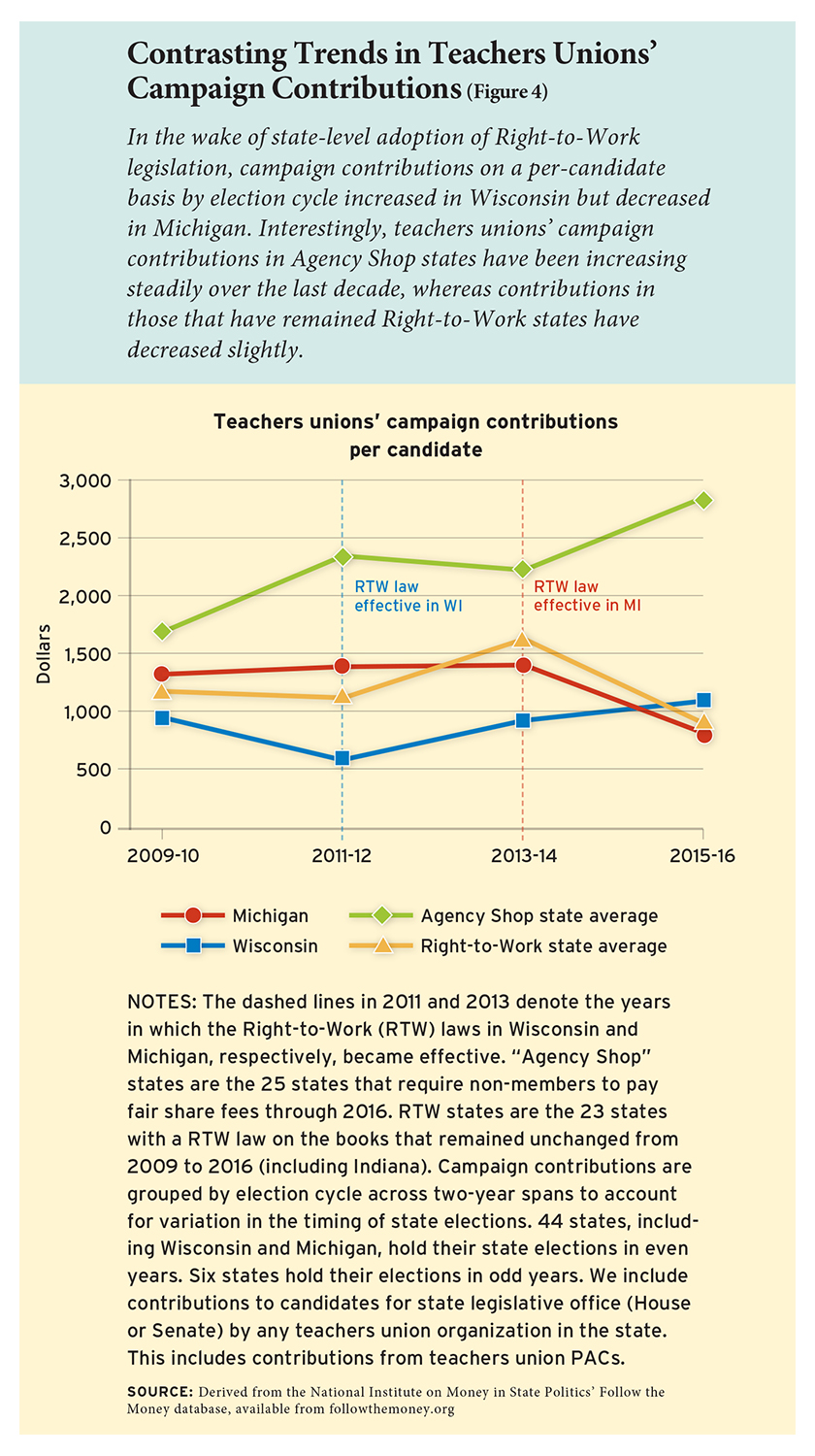 In other research, we have found evidence that teachers unions are growing accustomed to challenges and learning to adapt in response. For example, they have traditionally garnered their strength and political power by aligning with Democrats in office, at both the state and federal level, including by making significant contributions to the Democrats’ political campaigns. But in the past two election cycles, Congress has flipped to Republican majorities in both the House of Representatives (2012) and Senate (2016). Rather than accepting defeat, teachers unions re-allocated their contributions and cultivated new relationships with a contingent of Republican lawmakers with whom, on at least some issues, they could agree. They adapted. They sought to maintain some influence inside the Beltway. They took wins where they could.
In other research, we have found evidence that teachers unions are growing accustomed to challenges and learning to adapt in response. For example, they have traditionally garnered their strength and political power by aligning with Democrats in office, at both the state and federal level, including by making significant contributions to the Democrats’ political campaigns. But in the past two election cycles, Congress has flipped to Republican majorities in both the House of Representatives (2012) and Senate (2016). Rather than accepting defeat, teachers unions re-allocated their contributions and cultivated new relationships with a contingent of Republican lawmakers with whom, on at least some issues, they could agree. They adapted. They sought to maintain some influence inside the Beltway. They took wins where they could.
We see evidence of similar flexibility in Wisconsin: in the wake of state-level adoption of right-to-work legislation, campaign contributions on a per-candidate basis by election cycle increased (see Figure 4). In contrast, campaign contributions by Michigan teachers unions decreased in the election cycle following that state’s right-to-work reform. Interestingly, teachers union campaign contributions in agency-shop states have been increasing steadily over the last decade, whereas contributions in those that have remained right-to-work states have decreased slightly, on average. It seems that teachers unions may be ramping up their contributions in agency-shop states to preserve what policy strongholds they have left or to stymie any additional reforms that might come on the coattails of the Janus decision.
With revenues down, where is this money coming from? We reviewed NEA tax filings, which include expenditures, and found evidence that affiliates in both Wisconsin and Michigan have drastically cut non-political spending relative to affiliate organizations in agency-shop and right-to-work states, including cutting union employees’ salary and benefits. The Wisconsin affiliate also has laid off union staff. By adapting how they use their resources, teachers unions may be able to spend more on elections, even as their membership and revenues shrink, in an attempt to foster friendlier policy outcomes.
Focusing on Teachers’ Voice
Another response to membership and revenue declines comes in the form of a return to the founding purpose of the unions: to give voice to a set of workers. We often think about teachers union power in terms of unions’ influence on electoral outcomes and the agendas of the politicians they help to elect. But they were founded to organize teachers and help them fight for what they believed they deserved. The unions do this not only by contributing to the campaigns of friendly legislators, but also by listening to their membership and standing for the working conditions and policies that benefit rank-and-file teachers.
It is possible—and we argue even likely—that the Janus ruling will cause union leadership to listen to their members in new ways. Unlike the status quo, when even non-members can be required to pay for union services, they will need to fight for every member, to convince them their services are worth paying for.
Evidence from our Michigan interviews suggests that this is exactly what teachers unions will do. We uncovered multiple examples of targeted efforts to attract and retain members, ranging from reminding members of major bargaining victories to describing money-saving membership benefits and fun “extras” intended to build morale. For example, one local union leader discussed strategies to promote the union’s value to its current members:
I really think it’s more about that message that we try to send out to our members and to people who aren’t members on what we’re actually giving them and what they’re getting for their money that they don’t necessarily see. I’m constantly letting them know that if we weren’t at the bargaining table this last time, [they] wouldn’t have gotten this or that. You’ve got to just continually remind them.
In a similar vein, an MEA leader with whom we spoke told us:
You’re trying to keep membership. People that leave the union are saying, “Why am I paying these dues? What am I getting out of it? Look at everything we’re losing. What are you doing for us?” And so our response to that is, “What would it be without us? Because we’re fighting. Everything you have, you have because of us . . . the MEA has done a very good job saying, “Hey! Would you have ever seen this without the MEA fighting for you? This never would have happened without us!”
Other union leaders told us of new ways to provide benefits to members, and to attract and retain members to the group. In some cases, these came in the form of monetary benefits not attached to compensation, such as college tuition subsidies for members’ children and grandchildren and discounts on homeowners’ and auto insurance. One local union leader told us that the MEA is providing funds for extras like intra-district events and games “to do things to get new members involved . . . We focus more on the members now than we have in the past.”
Another tactic union leaders mentioned was making sure younger teachers considered membership key to their professionalism. One union leader said:
I hope to build a culture that moves a mindset that the union is watching out for everybody. How do we get to our younger members? I think that when politicians try and put us in this box that we’re just about protecting bad teachers and duty-free lunch then yes, new teachers who think they’re “all that and a bag of chips” believe they don’t need the union. If they know what we’re really about—social justice, high-quality standards, and helping you be the best professional—then they want to be a part of that.
Life after Janus
The timing of the Janus decision has coincided directly with both the so-called “war on teachers” and the tail end of economic recovery from the Great Recession. In states like those that adopted right-to-work laws in the past decade, which have been hit hard by the recession and adopted reforms like limiting tenure and making performance evaluations more robust, teachers have also experienced flat state budgets or cuts to education spending after decades of expansion, as well as reduced investments in services for children.
It is no surprise, then, that the voice function of the union has been widely on display in recent months. No fewer than six states have seen full or partial teacher strikes, including West Virginia and Kentucky—two states that recently passed right-to-work legislation. In addition, both of these states and the other states that have experienced walkouts—North Carolina, Oklahoma, Colorado, and Arizona—have seen legislative changes to important teacher protections, including evaluation, tenure, and retirement or pension plans. In the states where teachers may feel most under attack, teachers and their unions are rising up and using their voices to protest. And these protests don’t just address traditional bread-and-butter union issues like teachers’ own compensation, but also more general improvements to public education funding.
If teachers unions and teachers respond to the Janus ruling as they are responding to the removal of other protections, we may see the pundits who believe that Janus portends the end of teachers unions—and the reformers who intend for Janus to bring unions to their knees—surprised by their resiliency. By causing teachers unions to return to collective action on behalf of their members, the Supreme Court decision may, in the end, invigorate the unions that these court cases and the groups that sponsored them intended to incapacitate.
As is fitting given this argument, we end by drawing on the voice of one teachers union leader in Michigan:
Right-to-work to me isn’t an issue, because I think people are still joining their unions. They believe in public education. They believe in democracy. They know it’s the right thing to do. Who else is our voice?
Bradley D. Marianno is assistant professor of educational policy and leadership at the University of Nevada, Las Vegas, and Katharine O. Strunk is the Clifford E. Erickson Distinguished Professor of Education Policy at Michigan State University.
Note: A slightly different version of this article appeared prior to the Janus decision and was updated in July 2018.
This article appeared in the Fall 2018 issue of Education Next. Suggested citation format:
Marianno, B.D., and Strunk, K.O. (2018). After Janus: A new era of teachers union activism. Education Next, 18(4), 18-25.


